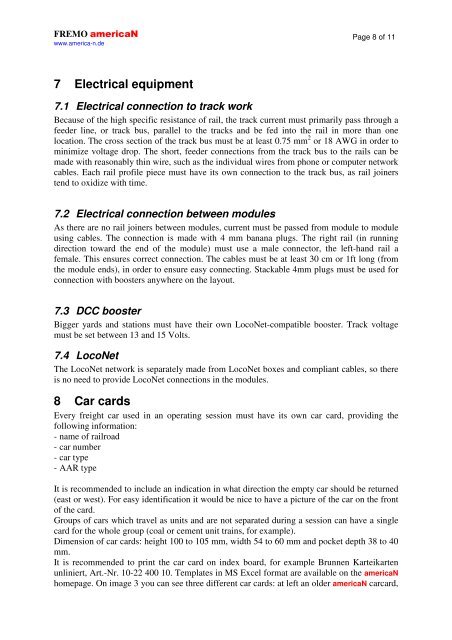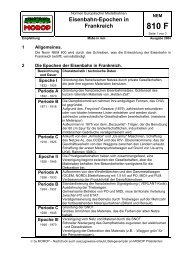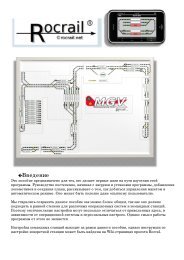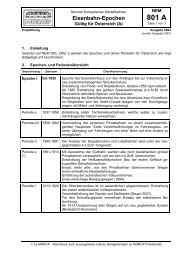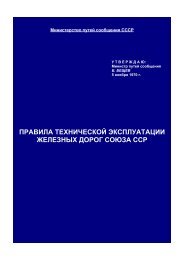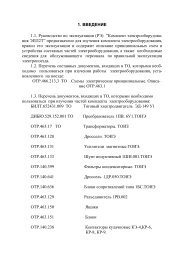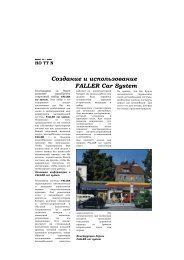Standards for the FREMO modular system
Standards for the FREMO modular system
Standards for the FREMO modular system
Create successful ePaper yourself
Turn your PDF publications into a flip-book with our unique Google optimized e-Paper software.
<strong>FREMO</strong> americaN<br />
www.america-n.de<br />
7 Electrical equipment<br />
Page 8 of 11<br />
7.1 Electrical connection to track work<br />
Because of <strong>the</strong> high specific resistance of rail, <strong>the</strong> track current must primarily pass through a<br />
feeder line, or track bus, parallel to <strong>the</strong> tracks and be fed into <strong>the</strong> rail in more than one<br />
location. The cross section of <strong>the</strong> track bus must be at least 0.75 mm 2 or 18 AWG in order to<br />
minimize voltage drop. The short, feeder connections from <strong>the</strong> track bus to <strong>the</strong> rails can be<br />
made with reasonably thin wire, such as <strong>the</strong> individual wires from phone or computer network<br />
cables. Each rail profile piece must have its own connection to <strong>the</strong> track bus, as rail joiners<br />
tend to oxidize with time.<br />
7.2 Electrical connection between modules<br />
As <strong>the</strong>re are no rail joiners between modules, current must be passed from module to module<br />
using cables. The connection is made with 4 mm banana plugs. The right rail (in running<br />
direction toward <strong>the</strong> end of <strong>the</strong> module) must use a male connector, <strong>the</strong> left-hand rail a<br />
female. This ensures correct connection. The cables must be at least 30 cm or 1ft long (from<br />
<strong>the</strong> module ends), in order to ensure easy connecting. Stackable 4mm plugs must be used <strong>for</strong><br />
connection with boosters anywhere on <strong>the</strong> layout.<br />
7.3 DCC booster<br />
Bigger yards and stations must have <strong>the</strong>ir own LocoNet-compatible booster. Track voltage<br />
must be set between 13 and 15 Volts.<br />
7.4 LocoNet<br />
The LocoNet network is separately made from LocoNet boxes and compliant cables, so <strong>the</strong>re<br />
is no need to provide LocoNet connections in <strong>the</strong> modules.<br />
8 Car cards<br />
Every freight car used in an operating session must have its own car card, providing <strong>the</strong><br />
following in<strong>for</strong>mation:<br />
- name of railroad<br />
- car number<br />
- car type<br />
- AAR type<br />
It is recommended to include an indication in what direction <strong>the</strong> empty car should be returned<br />
(east or west). For easy identification it would be nice to have a picture of <strong>the</strong> car on <strong>the</strong> front<br />
of <strong>the</strong> card.<br />
Groups of cars which travel as units and are not separated during a session can have a single<br />
card <strong>for</strong> <strong>the</strong> whole group (coal or cement unit trains, <strong>for</strong> example).<br />
Dimension of car cards: height 100 to 105 mm, width 54 to 60 mm and pocket depth 38 to 40<br />
mm.<br />
It is recommended to print <strong>the</strong> car card on index board, <strong>for</strong> example Brunnen Karteikarten<br />
unliniert, Art.-Nr. 10-22 400 10. Templates in MS Excel <strong>for</strong>mat are available on <strong>the</strong> americaN<br />
homepage. On image 3 you can see three different car cards: at left an older americaN carcard,


